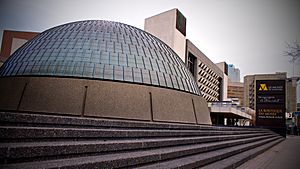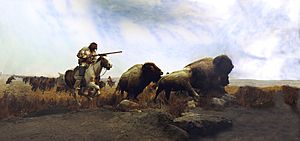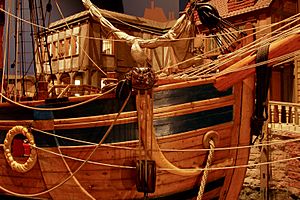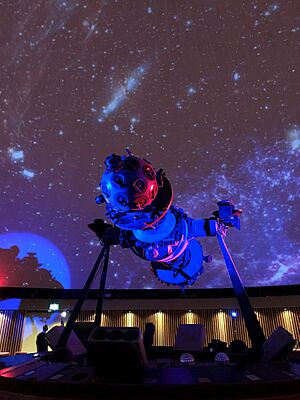Manitoba Museum facts for kids
 |
|
| Former name | Manitoba Museum of Man and Nature |
|---|---|
| Established | 1965 |
| Location | Winnipeg, Manitoba, Canada |
| Type | provincial human and natural history museum |
| Key holdings | Hudson's Bay Company Collection |
| Visitors | 303,191 (2017) |
| Architect | Herbert Henry Gatenby Moody |
| Owner | Manitoba Centennial Centre |
The Manitoba Museum is a special place in Winnipeg, Manitoba, Canada. It's the biggest museum in the province that teaches about human history and the natural world. It's also a non-profit center for learning about heritage and science.
The museum was designed in 1965 by Herbert Henry Gatenby Moody. It includes a Planetarium and a Science Gallery. The museum collects, researches, and shares stories about Manitoba's history, culture, and environment.
In 1994, the Hudson's Bay Company (HBC) gave its huge collection of historical items to the museum. This was the biggest gift the museum had ever received from a company.
Contents
History of the Museum
Early Beginnings
In 1879, a group called the Historical and Scientific Society of Manitoba started collecting historical items. In the early 1890s, there was a small Manitoba Museum in the basement of Winnipeg's City Hall. However, by 1900, there wasn't a public museum in the city.
From 1911 to the early 1920s, some private collections were shown in the Exposition Building in Winnipeg. The current museum still has some of these items today.
In 1932, a new group called the Manitoba Museum Association was formed. The Manitoba Museum officially opened its doors on December 15, 1932. It was located in the Winnipeg Civic Auditorium, next to the Winnipeg Art Gallery. The museum stayed there until 1967.
The museum grew with help from groups like the Carnegie Corporation of New York. Professors from the University of Manitoba also played a big part. Volunteers and a small staff helped run the museum.
As the museum got more items and more visitors, it needed a bigger space. So, in 1954, plans began for a new, modern museum. Funding for this new museum came from federal projects. These projects aimed to create new cultural places for Canada's 1967 Canadian Centennial celebration.
Building the New Museum
In 1964, a plan for a new museum and planetarium was given to the Manitoba government. The plan said that Manitoba needed a modern museum. It would show the history of people and their environment. It would also explore Manitoba's resources, industries, and culture.
In 1965, new laws created two new organizations. These were the Manitoba Museum of Man and Nature and the Manitoba Planetarium. They were part of plans to build a new Manitoba Centennial Centre. H. David Hemphill became the managing director in 1970. Paid jobs for curators were created, and the old volunteer curators joined an advisory group. Most of the valuable collections were moved to the new organization. The collections were stored while the new building was finished. The original museum building cost about $3.5 million.
The planetarium opened on May 15, 1968. The new museum facilities opened on July 15, 1970. Her Majesty Queen Elizabeth II officially opened them. This was part of Manitoba's 100th birthday celebration. The collections from the old Manitoba Museum formed the basis for this new museum.
In July 1972, the museum and planetarium became one place. It was called the Manitoba Museum of Man and Nature. In December 1996, the Manitoba Museum Foundation was created. The museum then became known simply as The Manitoba Museum. It also added a science gallery. Over time, more galleries were added. These included exhibits on earth history, sea-trading, the Arctic, and the Boreal forest.
The museum officially returned to the name, The Manitoba Museum, in 1997.
Modern Updates and Expansions
In 1994, the Hudson's Bay Company (HBC) chose the Manitoba Museum to keep its historical collection forever. To hold this collection, a new part of the museum was built in 1996. This new wing opened in September 1998. The Hudson's Bay Archives opened there on May 2, 2000.
In 1995, the museum added Alloway Hall. This created a larger space for special traveling exhibits. In 2017, Alloway Hall was made even bigger. It doubled in size to about 9,750 square feet. This project cost $5.3 million and was paid for by governments and foundations. The space has modern lighting and large windows.
In September 2003, the Parklands / Mixed-Woods Gallery opened. This completed the museum's big plan to show the history of all of Manitoba. A new Science Gallery opened in 2008. In 2018, the Nonsuch Gallery was updated. This happened for the 350th anniversary of the Nonsuch ship's voyage.
On November 1, 2019, the museum opened its Winnipeg Gallery. This was the first new permanent exhibit space since 2003. The museum also worked on upgrading its heating and cooling system in 2019.
Since 2020, the Manitoba Museum has offered online tours and programs. This is due to rules from the COVID-19 pandemic. For example, they have a weekly 'DOME@HOME' program from the Planetarium.
On April 8, 2021, the museum opened its Prairies Gallery. This finished a big $20.5 million project. This project also updated the Nonsuch Gallery, created the new Winnipeg Gallery, and renewed the Boreal Forest Corridor and Welcome Gallery.
Collections and Museum Galleries
The Manitoba Museum has over 2.9 million items! These items show the human and natural history of Manitoba. Visitors can explore these through nine main galleries.
These galleries explore the history and environment of the province. They cover everything from the northern Arctic coast to the southern prairie grasslands. The galleries include:
- Welcome Gallery (updated 2021)
- Earth History Gallery (opened 1973)
- Arctic/Sub-Arctic Gallery (opened 1976)
- Boreal Forest Gallery (opened 1980, corridor updated 2018)
- Nonsuch Gallery (updated 2018)
- HBC Gallery (opened 2000)
- Parklands / Mixed-Woods Gallery (opened 2003)
- Prairies Gallery (opened 2021)
- Winnipeg Gallery (opened 2019)
The Welcome Gallery has a diorama showing a Métis hunter on horseback chasing bison. A new exhibit in this gallery shows medals and pipes related to treaties. This shows the museum works with Indigenous peoples to share Manitoba's history accurately.
The Earth History Gallery shows Manitoba's geological history. You can see fossils from the Ordovician Sea, which covered the province long ago. Look for giant trilobites, plesiosaurs, and mosasaurs. These creatures lived in Manitoba nearly 80 million years ago. The Ancient Seas exhibit has a virtual underwater view of the Hudson Bay region from the Ordovician period. The Manitoba Museum was the first Canadian museum to show ancient marine life from 450 million years ago.
The Nonsuch Gallery features a full-size replica of the ship Nonsuch. This ship's voyage in 1668 led to the start of the Hudson's Bay Company (HBC). The gallery looks like a wharf in England in 1669, where the ship has 'docked'. The Nonsuch replica was built in England in 1968. It celebrated the HBC's 300th anniversary. It sailed 14,000 kilometers before arriving at the museum in 1974. The gallery walls were built around the replica, so it can't be removed without taking it apart. It was built using 17th-century hand tools and is considered one of the best replicas in the world.
The Winnipeg Gallery opened on November 1, 2019. It tells the story of Winnipeg's growth over the last century. It includes Indigenous history and Manitoba's 150 years of immigration. The gallery has a stained-glass logo of Winnipeg. This logo used to be in the old City Hall. There's also a film that shows Winnipeg's history in order. Themes include Winnipeg as an "Indigenous Homeland" and a "City of Newcomers." The gallery also has a "Personalities Wall" showing 30 important people from the city's history. The popular Urban Gallery exhibit, now called Winnipeg 1920, is part of this new gallery. It shows a Winnipeg street scene from the 1920s.
The Prairies Gallery opened on April 8, 2021. It shows the history of the Manitoba prairies through time. It explores how people connect to the land. It also features the plants, animals, and fungi found there. This gallery was created with advice from Indigenous groups and newcomers to Manitoba.
HBC Collection
By the 1900s, the Hudson's Bay Company (HBC) started collecting items. These included natural history items, human history artifacts, and pictures. They all related to the company's work in North America. The company collected items for display at its main office in London. Many of its employees in North America also collected their own items.
On May 2, 1920, the HBC hired Francis David Wilson. His job was to collect historical items and stories for a museum. This was for the company's 250th anniversary. Half of the collection came from First Nations, Métis, and Inuit communities. The HBC got these items through buying, trading, and gifts from fur traders. The collections were meant to show the HBC's role in developing British North America. They were seen as a "gift to the nation."
In June 1922, the HBC put on a big exhibit at its store in Winnipeg. By 1926, the museum exhibit was in new rooms at the current store on Portage Avenue. The goal was to show the history of the Hudson's Bay Company. It also showed life in the fur trade, pioneer settlers, and the customs of Indigenous tribes.
The HBC took good care of the collections. The exhibit became one of the first major public museums in Western Canada. The collection is also one of the world's most important historical resources.
In 1994, the HBC chose the Manitoba Museum as the permanent home for its historical collection. This collection shows over 300 years of HBC history. The museum then held two exhibits of the collection, in 1995 and 1997. In 1996, building began for a new wing to house the collection. The Prince of Wales dedicated the building. The building, which included a research area and public gallery, was finished in 1998. The Hudson's Bay Gallery officially opened to the public on May 2, 2000. The items in the gallery tell stories, including the search for the Northwest Passage. They also show how the HBC built its trading empire.
Planetarium
The Manitoba Museum Planetarium opened on May 15, 1968. The planetarium offers live shows. These shows combine pre-recorded videos of the sky and space with comments and questions from a presenter. They also have full dome films for families. These films often have a live show part before or after.
In 2012, the Manitoba Museum was the first planetarium in Canada to use Digistar® 5 technology. This technology lets visitors see the sky from anywhere on Earth, or even in the galaxy. You can see how it looked in the past or how it might look in the future. The original projector, nicknamed 'Marvin', is still in the planetarium theatre, even though it's no longer used.
Science Gallery
The Manitoba Museum Science Gallery is a place for hands-on learning. Each exhibit explains the science behind the experience. The Science Gallery was updated in 2016 and got two new permanent exhibits. The Brickyard: Build with LEGO Bricks lets you experiment with engineering using Lego tables. The Engineered for Speed Race Track lets visitors build their own toy race car and test it against others.
On March 22, 2014, the Lake Winnipeg: Shared Solutions exhibit opened in the Science Gallery. This exhibit has a computer game about the Lake Winnipeg watershed. In the game, visitors act as guardians of the lake. They decide what problems to solve and how. This exhibit cost over $1 million. It received support from many organizations.
Affiliations
The museum building is owned by the Manitoba Centennial Centre. They are also in charge of cleaning the museum.
The Manitoba Museum is connected with several organizations. These include the Canadian Museums Association, Canadian Heritage Information Network, and the Canadian Association of Science Centres. It is also affiliated with the Virtual Museum of Canada.
See also
 In Spanish: Museo Manitoba para niños
In Spanish: Museo Manitoba para niños






